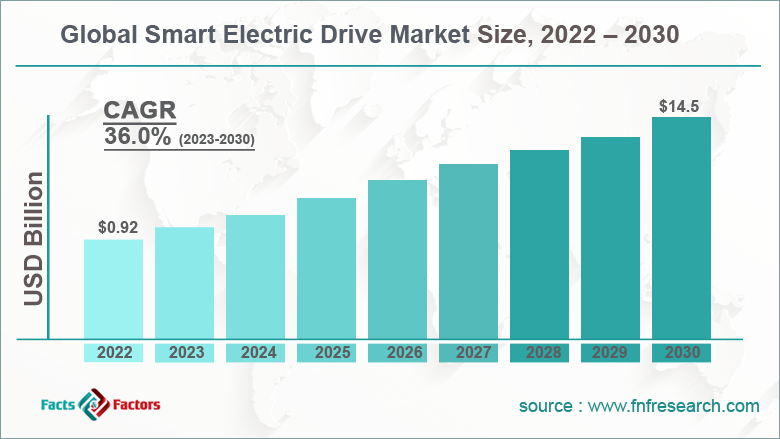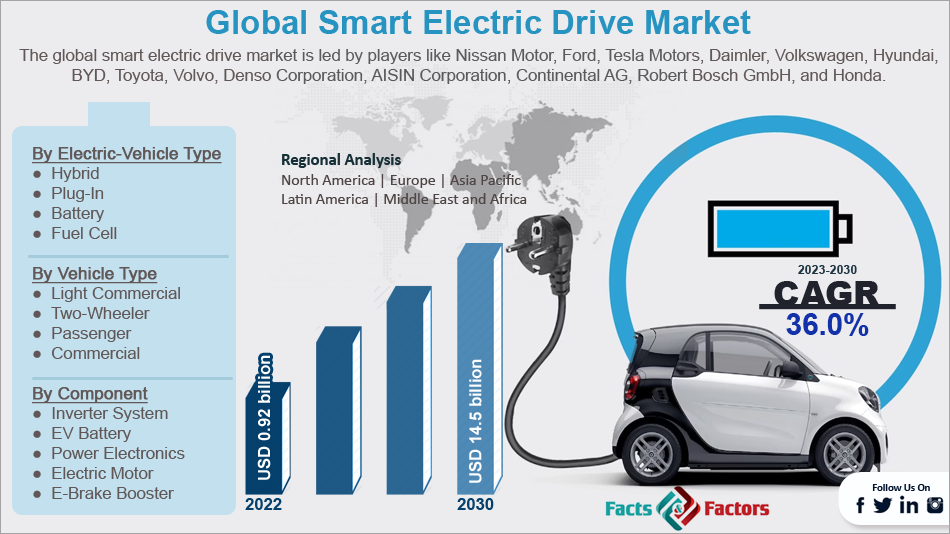Search Market Research Report
Smart Electric Drive Market Size, Share Global Analysis Report, 2023 – 2030

Smart Electric Drive Market Size, Share, Growth Analysis Report By Electric-Vehicle Type (Hybrid, Plug-In, Battery, and Fuel Cell), By Vehicle Type (Light Commercial, Two-Wheeler, Passenger, and Commercial), By Component (Inverter System, EV Battery, Power Electronics, Electric Motor, and E-Brake Booster), By Drive Type (All Wheel Drive, Rear Wheel Drive, And Front Wheel Drive), and By Region - Global and Regional Industry Insights, Overview, Comprehensive Analysis, Trends, Statistical Research, Market Intelligence, Historical Data and Forecast 2023 – 2030
Industry Insights
[230+ Pages Report] According to the report published by Facts Factors, the global smart electric drive market size was worth around USD 0.92 billion in 2022 and is predicted to grow to around USD 14.5 billion by 2030 with a compound annual growth rate (CAGR) of roughly 36% between 2023 and 2030. The report analyzes the global smart electric drive market drivers, restraints/challenges, and the effect they have on the demands during the projection period. In addition, the report explores emerging opportunities in the smart electric drive market.

 Market Overview
Market Overview
Smart electric drive revolves around the utilization of powertrain technology run by electricity. The final intention of the fraternity is to assist in reducing the negative impact on the environment while also performance efficiency. The global industry is inclusive of all types of electric vehicles that are produced and sold in the commercial market by Smart which is a subsidiary of Daimler AG.
The company is Germany-based and a global leader in the automotive corporation. It is responsible for the manufacturing of a variety of luxury trucks, coaches, buses, and other types of vehicles. It is currently one of the largest producers and sellers of commercial vehicles along with premium cars. It is the parent company of several popular brands like Fuso, Mercedes-Benz, Setra, and Western Star to name a few. One of the subsidiaries is Smart which includes a range of models in its Electric Drive segment like Smart EQ for four and Smart EQ for two, which are fully powered by electricity and designed specifically for urban areas.
 Key Insights
Key Insights
- As per the analysis shared by our research analyst, the global smart electric drive market is estimated to grow annually at a CAGR of around 36% over the forecast period (2022-2030)
- In terms of revenue, the global smart electric drive market size was valued at around USD 0.92 billion in 2022 and is projected to reach USD 14.5 billion, by 2030.
- The market is projected to grow at a significant rate due to the growing environmental concerns
- Based on distribution channel segmentation, veterinary hospitals & clinics were predicted to show maximum market share in the year 2022
- Based on electric-vehicle type segmentation, the battery was the leading type in 2022
- On the basis of region, Asia-Pacific was the leading revenue generator in 2022

 Growth Drivers
Growth Drivers
- Growing environmental concerns to propel market growth
The global smart electric drive market is projected to grow owing to the increasing concerns over the environmental impact of operational activities in the automotive segment. The industry is one of the largest contributors to the growing environmental pollution rate. Factors like continuous carbon emissions from vehicles that run on petrol, gas, or diesel along with the emission of harmful pollutants including nitrogen oxides and volatile organic compounds. Most of the businesses operating in the automotive segment have increased their efforts toward managing the growing concerns over environmental impact.
 Restraints
Restraints
- The high initial investment to restrict market expansion
EVs are generally more expensive than traditional vehicles. This is due to the high cost that is associated with the batteries used to power EVs. These battery systems are highly customized and require special resources for them to deliver effective performance.
Additionally, although there is significant growth in the range of EVs available in the commercial market, it is still considerably low when compared to traditional vehicles. These factors can limit the addition of new players over time due to limited accessibility to the product, especially in remote areas that may not have the supportive infrastructure to promote EV adoption.
 Opportunities
Opportunities
- Research & development surrounding battery technology to promote further growth
One of the main factors that could open more doors for further growth in the global industry is the increasing investment directed toward the development of new and advanced battery technology systems. This can be witnessed in the variety of resources used to develop new-age battery systems that are capable of outperforming all the previous editions. This is also inclusive of battery designs and chemistries. Industry players have amped up monetary and non-monetary resources to develop high-performing battery systems and the segment is consistently evolving.
 Challenges
Challenges
- Range anxiety, a true phenomenon in the industry
One of the key challenges faced by global market players is the management of range anxiety, which is a true phenomenon that is generally witnessed in the consumer segment, especially people who have opted for EVs. The phenomenon explains the fear of running out of power before the passenger can reach the desired destination or location. The occurrence of the phenomenon could be due to a lack of knowledge or the general perception which may be difficult to change.
 Segmentation Analysis
Segmentation Analysis
The global smart electric drive market is segmented based on an electric vehicle, vehicle type, component, drive type, and region
Based on electric-vehicle type, the global market segments are hybrid, plug-in, battery, and fuel cell.
- In 2022, the global market registered the highest growth in the battery segment. These vehicles are completely powered by an electric motor and do not have an internal combustion engine
- They are also made of the rechargeable battery pack
- The popularity of the segment is because they offer zero emissions and have lower operating costs while being more effective in performance as compared to other types
- Furthermore, the growing advancements in different types of batteries could help in generating higher revenue
- The average operational cost of an EV is between USD 0.05 to USD 0.1 per mile, as per the US Department of Energy
Based on vehicle type, the global market segments are light commercial, two-wheeler, passenger, and commercial.
Based on components, the global market is divided into inverter systems, EV batteries, power electronics, electric motors, and e-brake boosters.
- The global industry witnessed the highest growth in the electric motor segment and it may continue to dominate during the projection period
- The electric motor is the most significant component since it is required for propulsion and also assists in converting electrical energy into mechanical energy
- The power output index and efficiency of the electric motor determine the overall performance of the EV and its range
- Typically, EVs exhibit a range of 60 kW to more than 300 kW
Based on the drive type, the global market segments are all-wheel drive, rear-wheel drive, and front-wheel drive.
 Recent Developments:
Recent Developments:
- In September 2022, the automotive industry was introduced to a new range of Smart vehicles called the EV SUV. The vehicle became available for commercial sale in the UK in January 2023. It is the largest smart vehicle to be ever developed and offers a range of 273 miles
- In September 2022, Smart Automobile announced its entry into the Chinese market. Smart is backed by Mercedes-Benz and Geely. The vehicle launched in China ranges between mini hatch and small sports utility vehicle (SUV), and as per experts it is more like the latter types. It is 4.27 meters lengthwise
- In February 2022, Smart revamped its business strategy and entered a new segment of innovation by officially unveiling the name of its next-generation vehicles. The new model in the family is called #1 after completing a series of winter and aerodynamic tests
 Report Scope
Report Scope
Report Attribute |
Details |
Market Size in 2022 |
USD 0.92 Billion |
Projected Market Size in 2030 |
USD 14.50 Billion |
CAGR Growth Rate |
36% CAGR |
Base Year |
2022 |
Forecast Years |
2023-2030 |
Key Market Players |
Nissan Motor, Ford, Tesla Motors, Daimler, Volkswagen, Hyundai, BYD, Toyota, Volvo, Denso Corporation, AISIN Corporation, Continental AG, Robert Bosch GmbH, Honda, and others. |
Key Segment |
By Electric-Vehicle Type, Vehicle Type, Component, Drive Type, and Region |
Major Regions Covered |
North America, Europe, Asia Pacific, Latin America, and the Middle East &, Africa |
Purchase Options |
Request customized purchase options to meet your research needs. Explore purchase options |
 Regional Analysis
Regional Analysis
- Asia-Pacific to dominate with the highest market share
The global smart electric drive market is anticipated to witness the highest growth in Asia-Pacific with China controlling more than 39% of the global revenue share. Smart made its entry into the Chinese market in 2022 and has managed to create a strong consumer database. It is one of the world’s most densely populated regions with more than 1.2 billion population.
Concurrently, it is also one of the fastest-growing economies that are moving rapidly toward urbanization. The main market segment for Smart EVs are urban population and it perfectly fits the requirement of densely populated urban cities like the ones in China. Furthermore, the automobile manufacturer has shown immense interest in expanding in the country using better and more efficient strategic collaboration influenced by the growing demand for compact and eco-friendly cars. Europe is projected to grow at a significant CAGR driven by the presence of high-selling market players and higher adoption of EVs.
 Competitive Analysis
Competitive Analysis
- Nissan Motor
- Ford
- Tesla Motors
- Daimler
- Volkswagen
- Hyundai
- BYD
- Toyota
- Volvo
- Denso Corporation
- AISIN Corporation
- Continental AG
- Robert Bosch GmbH
- Honda
The global smart electric drive market is segmented as follows:
 By Electric-Vehicle Type Segment Analysis
By Electric-Vehicle Type Segment Analysis
- Hybrid
- Plug-In
- Battery
- Fuel Cell
 By Vehicle Type Segment Analysis
By Vehicle Type Segment Analysis
- Light Commercial
- Two-Wheeler
- Passenger
- Commercial
 By Component Segment Analysis
By Component Segment Analysis
- Inverter System
- EV Battery
- Power Electronics
- Electric Motor
- E-Brake Booster
 By Drive Type Segment Analysis
By Drive Type Segment Analysis
- All Wheel Drive
- Rear Wheel Drive
- Front Wheel Drive
 By Regional Segment Analysis
By Regional Segment Analysis
- North America
- The U.S.
- Canada
- Mexico
- Europe
- France
- The UK
- Spain
- Germany
- Italy
- Nordic Countries
- Denmark
- Sweden
- Norway
- Benelux Union
- Belgium
- The Netherlands
- Luxembourg
- Rest of Europe
- Asia Pacific
- China
- Japan
- India
- Australia
- South Korea
- Southeast Asia
- Indonesia
- Thailand
- Malaysia
- Singapore
- Rest of Southeast Asia
- Rest of Asia Pacific
- The Middle East & Africa
- Saudi Arabia
- UAE
- Egypt
- South Africa
- Rest of the Middle East & Africa
- Latin America
- Brazil
- Argentina
- Rest of Latin America
Industry Major Market Players
- Nissan Motor
- Ford
- Tesla Motors
- Daimler
- Volkswagen
- Hyundai
- BYD
- Toyota
- Volvo
- Denso Corporation
- AISIN Corporation
- Continental AG
- Robert Bosch GmbH
- Honda
Frequently Asked Questions

Copyright © 2024 - 2025, All Rights Reserved, Facts and Factors


